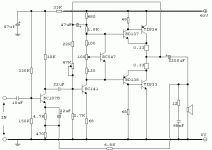Advice
Well...i belive it works fine...but it is a little bit old design...
I belive it can be upgraded in many ways...
You can try some other design that is allready much better than this.
Well...i belive it works fine...but it is a little bit old design...
I belive it can be upgraded in many ways...
You can try some other design that is allready much better than this.
Hi Dave!
The capacitor coupling between Q1 and Q2 can be avoided by replacing one of them with PNP type. Replacing Q1 would need fewer changes.
For other points refer to this fine article:
http://sound.westhost.com/project12.htm
Apart from the above mentioned, rather awkward capacitor coupling, your circuit corresponds to Fig.2 (Fig.1 showing the older quasi-complementary output stage). A suggestion is made, how to achieve DC coupling the speaker (Fig. 3).
Regards,
Peter Jacobi
The capacitor coupling between Q1 and Q2 can be avoided by replacing one of them with PNP type. Replacing Q1 would need fewer changes.
For other points refer to this fine article:
http://sound.westhost.com/project12.htm
Apart from the above mentioned, rather awkward capacitor coupling, your circuit corresponds to Fig.2 (Fig.1 showing the older quasi-complementary output stage). A suggestion is made, how to achieve DC coupling the speaker (Fig. 3).
Regards,
Peter Jacobi
This design is similar to what we used to design in the middle '60's. This was because pnp devices were much more expensive than caps and npn devices. It is best to direct couple where possible, so using a pnp device for the second stage removes the internal coupling cap, and makes the design better.
- Status
- Not open for further replies.
